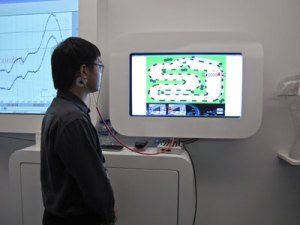 I am standing in a living-room-of-the-future. You can navigate the TV using hand movements, instantly swishing and touching to get subtitles to any international programming. Yes, a la Minority Report – but from across the room. Doesn’t every good living-room-of-the-future have a nod to Minority Report? (cc: Qwiki)
I am standing in a living-room-of-the-future. You can navigate the TV using hand movements, instantly swishing and touching to get subtitles to any international programming. Yes, a la Minority Report – but from across the room. Doesn’t every good living-room-of-the-future have a nod to Minority Report? (cc: Qwiki)
Meanwhile, on the patio-of-the-future, just off the living-room-of-the-future, a hologram of a lady tells me that the glass-sided windows of this loft are coated with a self-cleaning glass. Dirt beads up and, when it rains, it’s washed away. “Oh those rainstorms in the tropics!” she says with a slightly stilted laugh.
This isn’t Tomorrowland. It actually has a more Disneyland-sounding name if you can believe it– FUTUROPOLIS. People live and work here, crafting futuristic crazy research like this. Welcome to Singapore’s rare impractical side: Government-subsidized research conducted mostly by welcomed immigrants who can’t find this kind of science-fair-project cash elsewhere.
Elsewhere on the FUTUROPOLIS (sorry, it’s almost impossible to type that word without caps) demo floor, we see advertising that can detect if you are male or female and serve ads accordingly. A wall of motion-sensored fans blows when we walk past (above). We also pass a skeleton on an elliptical trainer. I have no idea what that was demonstrating, but I thought it was funny. (cc: Craig Ferguson) There’s also a bar of the future where you can take pictures that appear on the tables in front of you. You can add icons and hearts and scribble on them and send them to neighboring tables. Dating 3.0.
without caps) demo floor, we see advertising that can detect if you are male or female and serve ads accordingly. A wall of motion-sensored fans blows when we walk past (above). We also pass a skeleton on an elliptical trainer. I have no idea what that was demonstrating, but I thought it was funny. (cc: Craig Ferguson) There’s also a bar of the future where you can take pictures that appear on the tables in front of you. You can add icons and hearts and scribble on them and send them to neighboring tables. Dating 3.0.
To be fair to Futuropolis there are some potentially commercial– and life altering– applications like the hospital linens that detect when someone has been lying in the same spot too long and send a flashing BED SORE ALERT! (also impossible to type in lower case) notice to nurses. Another application allows people to drive a video  game car with the mind, something the guides say has won awards for its potential to helps ADD kids and stroke victims with brain functions. (Pictured to the left.) But (unfortunately) for the Valley, this is all way-out-there-stuff.
game car with the mind, something the guides say has won awards for its potential to helps ADD kids and stroke victims with brain functions. (Pictured to the left.) But (unfortunately) for the Valley, this is all way-out-there-stuff.
There is one area where Futuropolis and other research labs in Singapore are putting a lot of money that’s as important as DARPA’s early investments in the Internet for the future of society: Sustainable, healthy cities. I argued in my last post that comfortable Singapore wasn’t a short cut to understanding a mass-Asian customers. But Singapore is a great guinea pig for two things: Drug companies doing clinical trials and trying to understand the Asian genome and urban planners trying to figure out how to build a sustainable Asian megacity. Futuropolis is investing billions of research dollars in both.
Half of the budget goes to biomedical research and Walter Lee, head of the government’s Technology Transfer Network, told me that one company in the complex is doing ninety concurrent clinical trials for drug companies– taking advantage of Singapore’s Indian, Malaysian and Chinese melting-pot population. Web companies, luxury brands and KFC aren’t the only ones who benefit from the rising Asian middle class. As more people climb out of poverty, they demand basic healthcare products we take for granted in the West. The continent is also a huge growth area for pharmaceutical multinationals and for them, Singapore is a great hub of talent and government support for clinical trials. Emerging versus emerged doesn’t matter for their customers– they just need their genes.
Much of the other half goes to urban living research, whether it’s somewhat frivolous applications in the living-room-of-the-future or ways to repurpose human waste into fuel. Developing some real solutions for megacities could be even more important to people’s lives than medical research.
India is the extreme case of the need, with a legendarily outdated, poorly-planned urban infrastructure. There are regular power outages, sewage backups and the traffic is the worst I’ve seen in any city in the world. And, shockingly, less than 5% of Indians have cars and two-thirds of them still live in villages. If someone doesn’t come up with innovative solutions the cities will become unlivable as urban flight continues.
While Jakarta impressed me with a better urban infrastructure the last time I was here, in just four months it has become noticeably worse as the city keeps growing. The traffic is badly clogged at most times of day, and the power was out in the heart of the city for more than an hour last night. Both the Internet and mobile connections are far less reliable– a sign that more people are jumping on the networks without the construction of new towers. I have two local SIM cards in two phones; one can only receive calls, one can only make calls. Pre-paid mobile SIM cards are the lifeblood of an emerging market. It’s what ties the dual economies together. That’s the one part of the infrastructure a megacity has to get right.
China has done the best job of urban planning in Asia, although sometimes through draconian measures, like forcibly removing slum dwellers and requiring people have permission to move to a big city. But the country has also been forward thinking in the way it develops satellite cities, buildings housing and schools and gives companies incentives to move there to provide jobs. An impressive example I saw on my last trip to China was Suzhou, just outside of Shanghai. It used to be a comparatively sleepy Chinese city, known for its little rivers throughout the city and quaint architecture. (I know, “quaint” just isn’t a word you hear much in China, but downtown Suzhou is indeed quaint.)
But China constructed the Suzhou Industrial Park or (SIP) next to the city, constructing a river walk, luring companies, building luxurious mega-plexes, and an explosion of shopping and restaurants. Millions of people who can’t live in Shanghai live there instead and a have a comparable quality of life. Building a highspeed train connecting the two helps. You can live in Suzhou and still party in Shanghai. Some people are always going to want to live in the big cities, but as we’ve seen in America, if you give people other options where you can still have a modern lifestyle and a fulfilling job, not everyone does.
SIP was one of the first tech park experiments China did, supported by Deng Xioaping himself. Want to know who his partner in crafting it was? The City State of Singapore. Why did mighty China need tiny Singapore? For its glorious practicality in solving problems, unmuddied by religious, political or classist dogma and hangups. Futuropolis wants to come up with even more ways Singapore can export this practical problem solving to its overcrowded neighbors whether it’s advances in technologies like solar and wind, investments in clean water systems or even ways to repurpose human waste into a fuel to keep the lights on.
Singapore’s own traffic management systems aren’t perfect, but they do a lot to alleviate jams. The city has OK public transportation, but is building more. It does have an amazingly wired cab system: You call any of the three major cab company phone numbers, the system the broadcasts the job to all cabs in your vicinity and the first driver to bid for it gets the job. An SMS tells you the number of the cab assigned to you and how long it’ll be. When the cab shows up, the driver’s LCD display screen bears all your information to make sure the right person gets it. And unlike, say, a dispatch system, this one is highly user-friendly, works from any phone and in my experience actually delivered a cab. (Sorry, UberCab, Singapore is way ahead of you, and the government supports it.)
There are also overpasses throughout the city that deduct money from automated sensors everyone is required to have on their windshields (ala FastPass) if you want to drive on more central roads, and deducts more money during peak times. The city is working on a new GPS version of this that would be able to charge more by larger, gas-guzzling cars. The hope isn’t just to make money off of a traffic point like a toll booth– the hope is people find other ways to get from point A to point B.
A smaller-country’s path to economically outperforming its natural disadvantages depends on it seizing on what it can do that no one else can, like the village in Three Amigos that could sew. Singapore doesn’t have a mega-population. It never will. But it has the perfect ingredients for creating the model megacity: One of the highest population densities in Asia, a controllable geographic size to implement change and experiments, and billions in research dollars to make the seemingly impractical implementable one day. If it follows through on the promise I saw at places like Futuropolis, Singapore could be the single most important city to the future of emerging markets.
[UPDATE: Someone told me on Twitter it’s actually called “Fusionopolis,” which is weird because when I was in the building they said “Futuropolis.” Always possible I misunderstood…several times. It has been a long trip. I didn’t see anything on the building and the guy’s business card reads Technology Transfer Network. At any rate, Futuropolis is a much better name for what they do. Fusionopolis makes little sense. If I’m indeed wrong, or there are three names, consider that free consulting advice. You should change it to “Futuropolis.”]
